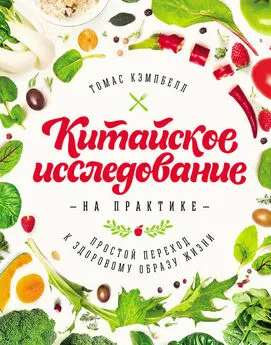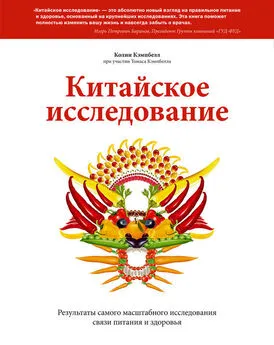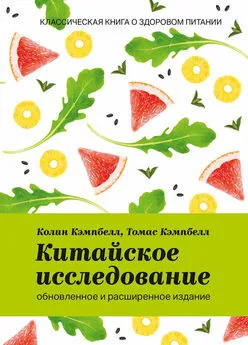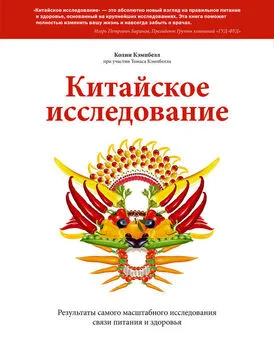Томас Кэмпбелл - Китайское исследование на практике. Простой переход к здоровому образу жизни
- Название:Китайское исследование на практике. Простой переход к здоровому образу жизни
- Автор:
- Жанр:
- Издательство:Манн, Иванов и Фербер
- Год:2015
- Город:Москва
- ISBN:978-5-00057-656-4
- Рейтинг:
- Избранное:Добавить в избранное
-
Отзывы:
-
Ваша оценка:
Томас Кэмпбелл - Китайское исследование на практике. Простой переход к здоровому образу жизни краткое содержание
На русском языке публикуется впервые.
Китайское исследование на практике. Простой переход к здоровому образу жизни - читать онлайн бесплатно ознакомительный отрывок
Интервал:
Закладка:
201
Hooper L., Thompson R. L., Harrison R. A. et al. Risks and benefits of omega 3 fats for mortality, cardiovascular disease, and cancer: Systematic review // BMJ, 2006. Vol. 332. Pp. 752–760.
202
Esselstyn C. B. Jr., Ellis S. G., Medendorp S. V., Crowe T. D. A strategy to arrest and reverse coronary artery disease: A 5-year longitudinal study of a single physician’s practice // Journal of Family Practice, 1995. Vol. 41. Pp. 560–568.
203
Willcox D. C., Willcox B. J., Todoriki H., Suzuki M. The Okinawan diet: Health implications of a low-calorie, nutrient-dense, antioxidant-rich dietary pattern low in glycemic load // Journal of the American College of Nutrition, 2009. Vol. 28 Suppl. Pp. 500S–516S.
204
Sanders T. A. DHA status of vegetarians // Prostaglandins, Leukotrienes, and Essential Fatty Acids, 2009. Vol. 81. Pp. 137–141.
205
Applied Research Program, National Cancer Institute. Usual intake of total grains, 2001–2004. April 2, 2014 // riskfactor.cancer.gov/diet/usualintakes/pop/grains_all.html.
206
Krebs-Smith S. M., Guenther P. M., Subar A. F. et al. Americans do not meet federal dietary recommendations // Journal of Nutrition, 2010. Vol. 140. Pp. 1832–1838.
207
Applied Research Program, National Cancer Institute. Usual intake of whole grains, 2001–2004. April 2, 2014 // riskfactor.cancer.gov/diet/usualintakes/pop/grains_all.html.
208
Bachman J. L., Reedy J., Subar A. F., Krebs-Smith S. M. Sources of food group intakes among the US population, 2001–2002 // Journal of the American Dietetic Association, 2008. Vol. 108. Pp. 804–814.
209
Sapone A., Bai J. C., Ciacci C. et al. Spectrum of gluten-related disorders: Consensus on new nomenclature and classification // BMC Medicine, 2012. Vol. 10. P. 13.
210
Boyce J. A., Assa’ad A., Burks A. W. et al. Guidelines for the diagnosis and management of food allergy in the United States: Report of the NIAID-sponsored expert panel. NIH Publication No. 11–7700. Bethesda, MD: National Institutes of Health, December 2010 // www.niaid.nih.gov/topics/foodallergy/clinical/documents/faguidelinesexecsummary.pdf.
211
Rona R. J., Keil T., Summers C. et al. The prevalence of food allergy: A metaanalysis // Journal of Allergy and Clinical Immunology, 2007. Vol. 120. Pp. 638–646.
212
Zuidmeer L., Goldhahn K., Rona R. J. et al. The prevalence of plant food allergies: A systematic review // Journal of Allergy and Clinical Immunology, 2008. Vol. 121. Pp. 1210–1218.e4.
213
Rashtak S., Murray J. A. Celiac disease in the elderly // Gastroenterology Clinics of North America, 2009. Vol. 38. Pp. 433–446.
214
Fasano A., Berti I., Gerarduzzi T. et al. Prevalence of celiac disease in at-risk and not-at-risk groups in the United States: A large multicenter study // Archives of Internal Medicine, 2003. Vol. 163. Pp. 286–292.
215
Fasano A., Catassi C. Celiac disease // New England Journal of Medicine, 2012. Vol. 367. Pp. 2419–2426.
216
Kellogg E. A. Evolutionary history of the grasses // Plant Physiology, 2001. Vol. 125. Pp. 1198–1205.
217
Karell K., Louka A. S., Moodie S. J. et al. HLA types in celiac disease patients not carrying the DQA1*05-DQB1*02 (DQ2) heterodimer: Results from the European Genetics Cluster on Celiac Disease // Human Immunology, 2003. Vol. 64. Pp. 469–477.
218
Trynka G., Wijmenga C., van Heel D. A. A genetic perspective on coeliac disease // Trends in Molecular Medicine, 2010. Vol. 16. Pp. 537–550.
219
Farrell R. J., Kelly C. P. Celiac disease and refractory celiac disease // M. H. Sleisenger, M. Feldman, L. S. Friedman, L. J. Brandt, eds. Sleisenger and Fordtran’s gastrointestinal and liver disease: Pathophysiology, diagnosis, management. 9th ed. Philadelphia: Saunders/Elsevier, 2010.
220
Simell S., Hoppu S., Hekkala A. et al. Fate of five celiac disease-associated antibodies during normal diet in genetically at-risk children observed from birth in a natural history study // American Journal of Gastroenterology, 2007. Vol. 102. Pp. 2026–2035.
221
Matysiak-Budnik T., Malamut G., de Serre N. P.-M. et al. Long-term follow-up of 61 coeliac patients diagnosed in childhood: Evolution toward latency is possible on a normal diet // Gut, 2007. Vol. 56. Pp. 1379–1386.
222
Myléus A., Hernell O., Gothefors L. et al. Early infections are associated with increased risk for celiac disease: An incident case-referent study // BMC Pediatrics, 2012. Vol. 12. P. 194.
223
Fasano A., Catassi C. Early feeding practices and their impact on development of celiac disease // Nestlé Nutrition Workshop Series: Pediatric Programme, 2011. Vol. 68. Pp. 201–209.
224
Shamir R. Can feeding practices during infancy change the risk for celiac disease? // Israel Medical Association Journal, 2012. Vol. 14. Pp. 50–52.
225
DePaolo R. W., Abadie V., Tang F. et al. Co-adjuvant effects of retinoic acid and IL-15 induce inflammatory immunity to dietary antigens // Nature, 2011. Vol. 471. Pp. 220–224.
226
Brown K., DeCoffe D., Molcan E., Gibson D. L. Diet-induced dysbiosis of the intestinal microbiota and the effects on immunity and disease // Nutrients, 2012. Vol. 4. Pp. 1095–1119.
227
Salmi T. T., Hervonen K., Kautiainen H. et al. Prevalence and incidence of dermatitis herpetiformis: A 40-year prospective study from Finland // British Journal of Dermatology, 2011. Vol. 165. Pp. 354–359.
228
Sapone A., Bai J. C., Ciacci C. et al. Spectrum of gluten-related disorders: Consensus on new nomenclature and classification // BMC Medicine, 2012. Vol. 10. P. 13.
229
Toscano V., Conti F. G., Anastasi E. et al. Importance of gluten in the induction of endocrine autoantibodies and organ dysfunction in adolescent celiac patients // American Journal of Gastroenterology, 2000. Vol. 95. Pp. 1742–1748.
230
Mahmud F. H., Murray J. A., Kudva Y. C. et al. Celiac disease in type 1 diabetes mellitus in a North American community: Prevalence, serologic screening, and clinical features // Mayo Clinic Proceedings, 2005. Vol. 80. Pp. 1429–1434.
231
Funda D. P., Kaas A., Bock T. et al. Gluten-free diet prevents diabetes in NOD mice // Diabetes/Metabolism Research and Reviews, 1999. Vol. 15. Pp. 323–327.
232
Pastore M. R., Bazzigaluppi E., Belloni C. et al. Six months of gluten-free diet do not influence autoantibody titers, but improve insulin secretion in subjects at high risk for type 1 diabetes // Journal of Clinical Endocrinology and Metabolism, 2003. Vol. 88. Pp. 162–165.
233
Elliott R. B., Reddy S. N., Bibby N. J., Kida K. Dietary prevention of diabetes in the nonobese diabetic mouse // Diabetologia, 1988. Vol. 31. Pp. 62–64.
234
van Belle T. L., Coppieters K. T., von Herrath M. G. Type 1 diabetes: Etiology, immunology, and therapeutic strategies // Physiological Reviews, 2011. Vol. 91. Pp. 79–118.
235
Knip M., Virtanen S. M., Sepp. K. et al. Dietary intervention in infancy and later signs of beta-cell autoimmunity // New England Journal of Medicine, 2010. Vol. 363. Pp. 1900–1908.
236
Carroccio A., Mansueto P., Iacono G. et al. Non-celiac wheat sensitivity diagnosed by double-blind placebo-controlled challenge: Exploring a new clinical entity // American Journal of Gastroenterology, 2012. Vol. 107. Pp. 1898–1906.
237
Biesiekierski J. R., Newnham E. D., Irving P. M. et al. Gluten causes gastrointestinal symptoms in subjects without celiac disease: A double-blind randomized placebo-controlled trial // American Journal of Gastroenterology, 2011. Vol. 106. Pp. 508–514.
238
Lundin K. E., Alaedini A. Non-celiac gluten sensitivity // Gastrointestinal Endoscopy Clinics of North America, 2012. Vol. 22. Pp. 723–734.
239
Sverker A., Hensing G., Hallert C. “Controlled by food” — Lived experiences of coeliac disease // Journal of Human Nutrition and Dietetics, 2005. Vol. 18. Pp. 171–180.
240
Riddle J., McEvoy M. What are the basic requirements for organic certification? Washington State Department of Agriculture, December 20, 2006 // agr.wa.gov/foodanimal/organic/Certificate/2006/OrganicRequirementsSimplified.pdf.
241
Heaton S. Organic farming, food quality and human health. Bristol, UK: Soil Association, 2001.
242
Magkos F., Arvaniti F., Zampelas A. Organic food: Buying more safety or just peace of mind? A critical review of the literature // Critical Reviews in Food Science and Nutrition, 2006. Vol. 46. Pp. 23–56.
243
Worthington V. Nutritional quality of organic versus conventional fruits, vegetables, and grains // Journal of Alternative and Complementary Medicine, 2001. Vol. 7. Pp. 161–173.
244
Magkos F., Arvaniti F., Zampelas A. Organic food: Nutritious food or food for thought? A review of the evidence // International Journal of Food Sciences and Nutrition, 2003. Vol. 54. Pp. 357–371.
245
Benbrook C., Zhao X., Yanez J. et al. New evidence confirms the nutritional superiority of plant-based organic foods. Washington, DC: Organic Center, 2008.
246
Dangour A. D., Dodhia S. K., Hayter A. et al. Nutritional quality of organic foods: A systematic review // American Journal of Clinical Nutrition, 2009. Vol. 90. Pp. 680–685.
247
Smith-Spangler C., Brandeau M. L., Hunter G. E. et al. Are organic foods safer or healthier than conventional alternatives? A systematic review // Annals of Internal Medicine, 2012. Vol. 157. Pp. 348–366.
248
Daley C. A., Abbott A., Doyle P. S. et al. A review of fatty acid profiles and antioxidant content in grass-fed and grain-fed beef // Nutrition Journal, 2010. Vol. 9. P. 10.
249
Baker B. P., Benbrook C. M., Groth E. 3rd, Lutz Benbrook K. Pesticide residues in conventional, integrated pest management (IPM)-grown and organic foods: Insights from three US data sets // Food Additives and Contaminants, 2002. Vol. 19. Pp. 427–446.
250
Lu C., Barr D. B., Pearson M. A., Waller L. A. Dietary intake and its contribution to longitudinal organophosphorus pesticide exposure in urban/suburban children // Environmental Health Perspectives, 2008. Vol. 116. Pp. 537–542.
251
Lu C., Toepel K., Irish R. et al. Organic diets significantly lower children’s dietary exposure to organophosphorus pesticides // Environmental Health Perspectives, 2006. Vol. 114. Pp. 260–263.
Читать дальшеИнтервал:
Закладка:





![Колин Кэмпбелл - Китайское исследование: обновленное и расширенное издание. Классическая книга о здоровом питании [litres]](/books/1059662/kolin-kempbell-kitajskoe-issledovanie-obnovlennoe.webp)




